How to Grow Olive Trees — even in Zone 7
Olive trees can be grow in the backyard, front yard or in a container! We grow them outdoors in zone 7! They are guaranteed to earn comments such as, “I didn’t know they grow here.” And YOU can grow them too. Heck, grow them just to have an olive branch as a symbol of peace!
Humans have relied on Olive Trees for thousands of years. And the tree lives for 150+ years! Some live for hundreds of years. As of today, there are hundreds of cultivars of the olive trees. Various cultivars influence the fruit’s color, size, shape, and quality varies, as well as the tree’s growing pattern. Be sure to select Olive Trees that produce “table olives,” if you plant on eating the olives you grow. Olive trees are productive for hundreds of years as long as they are pruned correctly and regularly.
Extra Virgin Olive Oil protects the heart, helps the gut, provides antioxidants, and has anti-inflammatory and anti-tumor properties. But did you know that the leaves have been used as a traditional food and herbal medicine? Studies on Olive Leaf Extracts have demonstrated anti-cancer, anti-atherosclerotic, anti-fungal, hypoglycemic, and cardioprotective effects. That’s the research! Who knew?!
This is a HEPPY™ plant. They need NO water once established, and the oil and leaves are VERY healthy for humans. They show little risk of disease and pests, and can grow in a variety of soils. Olive Trees are HEPPY plants!!

Olive Tree Plant Guide — on ONE ad-free webpage!
On this page:
1. Olive Tree Fact Sheet.
2. Growing & Caring for Olive Trees.
3. Buying Olive Trees.
4. Black, Green and Red Olives — for curing and making olive oil?
5. Curing Olives and Making Olive Oil.
6. Health benefits of Olive Oil and Olive Leaves!
7. Propagating Olive Trees.
8. Varieties we grow organically!
________________________________________
see our list of 400 edible plants
YouTube channel (please subscribe)
YouTube playlist for Olive Trees at HEPPY™ (please subscribe)
Olive Tree Fact Sheet
common names: Common Olive, European Olive
Zone: 7 to 10 (few species grow in zone 7)
Height: 10 to 30 feet
Native: Mediterranean
Bloom Time: June – July
Bloom Color: White
Fruit Maturity: August – October
Self-fertile: yes/no (depends on the variety)
Sun: full sun
Water: low, once established
Soil: forgiving (but not moist or wet)
Maintenance: low
Growth Rate: medium
Deciduous or evergreen: evergreen
Edible¹: yes (more information is below)]
Medicinal²: yes (discussed below)
Commercial viability: strong (discussed below)]
Family / Genus (species): Oleaceae / Olea (Olea europaea)
Remarks: PROTECT them well during winter if planted outside in zone 7; zone 8 and up (warmer) is better for Olives.
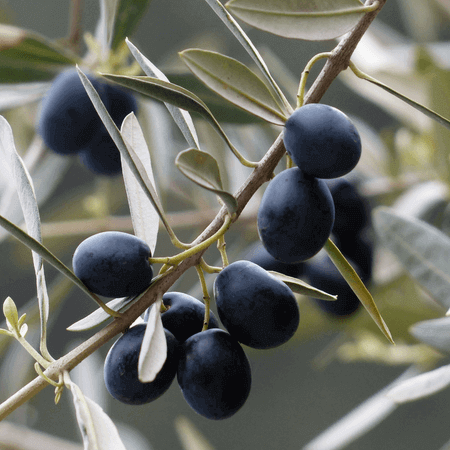
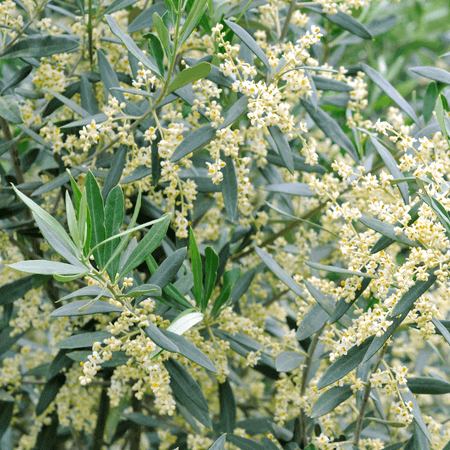
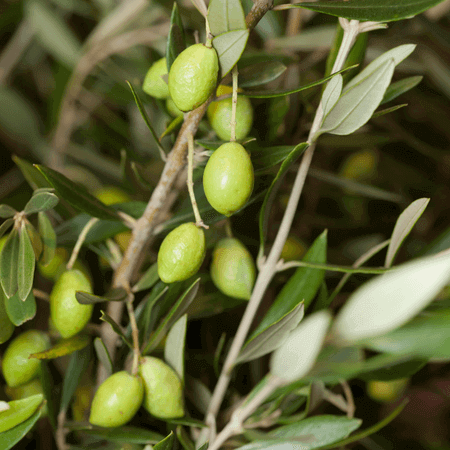
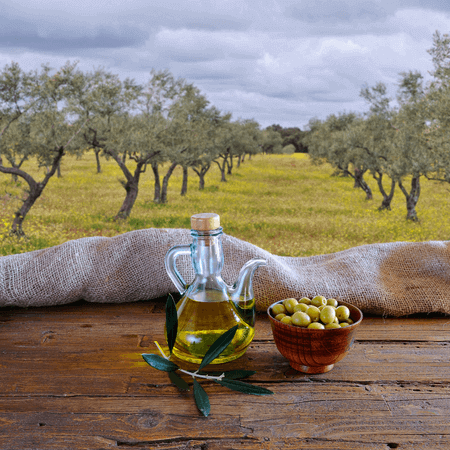

Growing & Caring for Olive Trees
Olive Trees begin producing well by age 5, and produce heavy crops for the next 50 years. “many trees continue to give good yields for hundreds of years, even when their trunk is hollow.”
they tolerate infertile soil, but prefer well-drained fertile soil. they also tolerate salty air.
plant Olive Trees in full sun and about 15 feet apart. they are drought tolerant once established. however, water them well when they’re young. they are easy to prune and to care for.
Soil
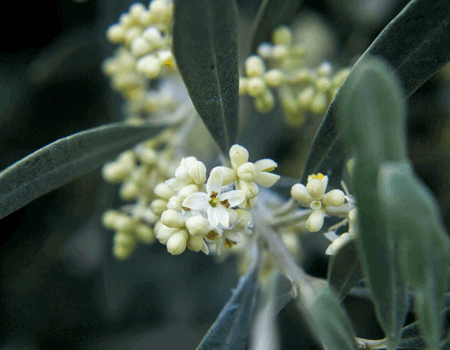
well-drained soil is a priority. Olive Trees’ grow naturally in soil that has a ph of 7.5 to 8.2. however, we grow Olive Trees in our organically rich tree plots (1/3 equal parts of native Maryland loam, decomposing woodchips and black compost soil). we used NO soil amendments AND we JUST planted them (2022). we’ll know more about our choice in a year or two.
IF i was smarter, I would have added lime to the soil. lime increases the soil’s ph, and is representative of the Olive Trees’ natural habitat. we’ll apply lime in the Fall or next Spring just to make the girls ‘feel at home!’
Olive Trees grow in the Mediterranean region’s “calcareous” soil. calcareous soil looks white & chalky. it’s limestone or calcium carbonate — made of tiny fossils, fossilized shell fragments and other fossilized debris. got fossilized seashell fragments in your soil? probably not 😉 . no worries. use lime or wood ash to raise the soil pH.
When applying lime to soil
“Maximum contact of lime with the soil is essential. Most liming materials are only slightly soluble in water, so incorporation in the soil [use shovel to mix with soil] is a must for lime reaction. Even when properly mixed with the soil, lime will have little effect on pH if the soil is dry. Moisture is essential for the lime-soil reaction to occur.” Clemson University Cooperative Extension Service, Changing The Ph Of Your Soil.
Planting
we planted our Nikita Jubilee Olive Tree in this vid. we planted ‘Nikki’ in June 2022.
10 steps to planting an Olive Tree — in 2 minutes time.
- soak soil. we also added Espoma’s Bio-tone to stimulate root growth.
- think about the plant’s position & limbs, relative to the sun. larger limbs should be aimed away from, or parallel to the sun’s location.
- soak the potted plant before removing it. that makes removal from pot easier.
- gently unravel the roots.
- checkout the rest of the vid….!
Pruning
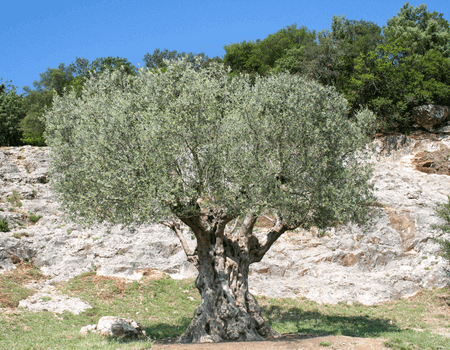
young Olive Trees require little pruning. the leaves are fetching sunlight and we want the roots to grow! they are very drought tolerant once established.
once established — 4+ feet (1.5 meters) — prune to the desired shape. they can be pruned to grow short & bushy, or tall with a round crown. overall, little pruning is needed.
when pruning, KEEP IN MIND that:
1. Olive Trees flower (fruit) on last year’s growth. prune annually in Spring. however, be mindful of last year’s new shoots and limbs.
2. They do NOT fruit on the same wood twice. stimulating healthy growth each year is important.
prune-away older growth in the center of the tree as the Olive Tree matures. that improves air circulation (reduces the risk of disease) and allows sunlight to more areas of the tree (stimulating flowering and healthy growth).
Watering and fertilize Olive Trees
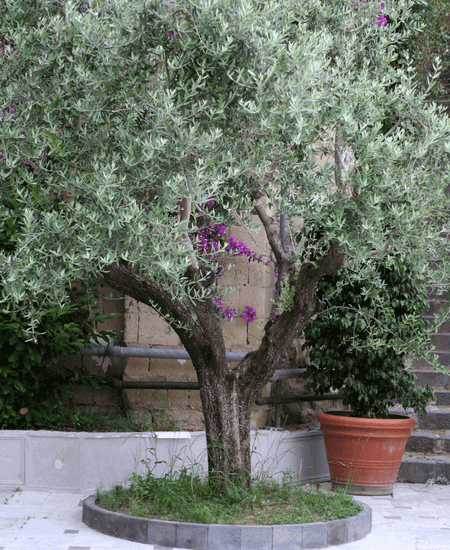
Watering
how often you water ALWAYS depends on your soil. in general, newly planted Olive Trees need water regularly. they should be planted in well-drained soil so water them deeply two or three times a week. “low & slow” is good (low volume of water for an extended period of time).
Olive Trees that are more than 4 years old should be well-established. they can be water less IF at all. we water 4+ year old trees in the Spring and in August, if August is exceptionally hot & dry. we don’t water much because of our well conditioned soil. also, it cuts-down on the need to prune. we never water in fall and winter.
Fertilizing
Olive Trees respond well to fertilizing. in particular, nitrogen.
a balanced 10-10-10 fertilizer is very inexpensive (walmart). we fertilize sparingly — once per year for ~all outdoor plants. we invested in creating optimal soil.
fertilize more often in less-than-optimal soil conditions. applying fertilizer monthly during the growing season is adequate.
Grow Olive Trees INDOORS
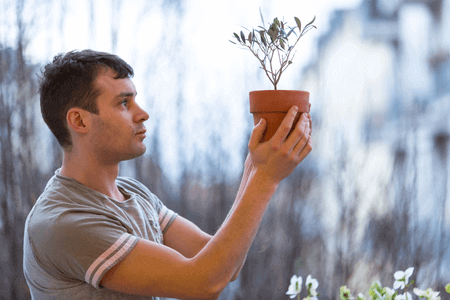
the key is sunlight. a lot of sunlight. bright, airy and as open as possible to have quality growth.
cactus mix provides light & airy soil. placing filler at the bottom of the pot helps. gravel is ideal but will make the pot heavy, which could be good or bad. any filler that doesn’t rot will work.
the type of pot your use can influence how often you water. for example, soil in clay pots dries out much sooner.
an INFREQUENT deep soak would be better than frequent watering. They are from the Mediterranean so be mindful that growing Olive Trees indoor requires little water.
Buying Olive Trees
Selecting Olive Trees
are you buying one tree or more than one cultivar? want it tall or short? are you growing them for food, olive oil or visual appeal?
Self-pollinating vs. Cross-pollinating Olive Trees
there are hundreds of cultivars of the Olive Trees, Olea europaea. some cultivars pollinate themselves and others need a second cultivar for cross-pollination. we will build a list of 100 Olive Trees. however, until them, the best links to find lists of trees that are self-pollinating or cross-pollinating is here:
Dwarf vs. Standard height Olive Trees
typically, Olive Trees grow from 10, 20 to 30 feet tall! so standard heights vary. however, i found two confirmed varieties of dwarf Olive Trees:
- Little Ollie Dwarf Olive, at 2-4 feet tall (0.6-1.2 meters). It is non-fruiting, from what i’ve read.
- Skylark Dwarf Olive Tree, at 6-8 feet tall (1.8-2.4 meters)
Select Olive Trees for Fruit, Olive Oil or Visual Appeal
select cultivars for making olives to eat (“table olives”), for oil production or visual appeal (fruitless). there are hundreds of cultivars so some research is required on your part. here are some highlights.
for table olives:
- Ascolano. grown in California; large fruit.
- Kalamata. just go to Costco. we eat TONS of Kalamata olives. we use the juice for salad dressing!
- Mission. HUGELY popular; an American cultivar with fascinating history; grown in California.
- Sevillano. a ‘chubby’ fruit that are commonly stuffed with pimientos, cheese or almonds.
for olive oil:
- Arbequina. grown in Spain; makes high quality, aromatic and fruity olive oil; oil has short self-life (1 year).
- Frantoio & Leccino. grown in Italy; makes gourmet olive oil; both are high yield and strong flavor.
- Koroneiki. grown in Greece for generations; makes high quality olive oil; oil has long self-life (2+ years).
for visual appeal:
- grows 2-8 feet tall, Little Ollie. a dwarf Olive Tree. does well in hot dry and coastal conditions & compact.
- grows 15-25 feet tall, Wilsonii. fruitless; tolerates hot & coastal conditions; medium size tree for containers.
- grows 25-30 feet tall, Swan Hill. fruitless; has the typical attractive Olive Tree foliage and form.
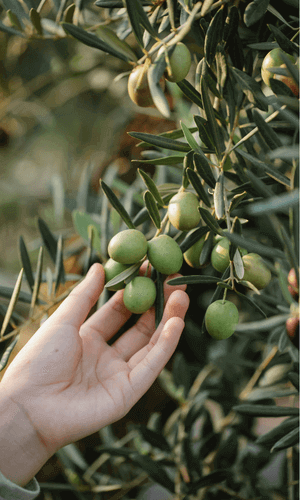

What's the difference between Black, Green and Red Olives?
an olive’s color is determined by how ripe the olive was when picked, and the curing process.
Black, Green & Red Olives
black olives are ripe when picked OR, green when picked and blackened in the curing process. they are generally soft olives because they’re picked ripe.
green olives are unripe when picked. green olives are dense and firm because they’re picked unripe.
red-brown colored olives are unique to the Kalamata cultivar. they are generally soft olives because they’re picked ripe.
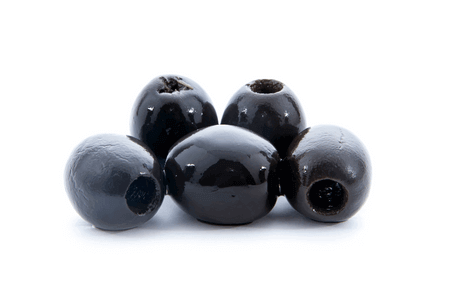

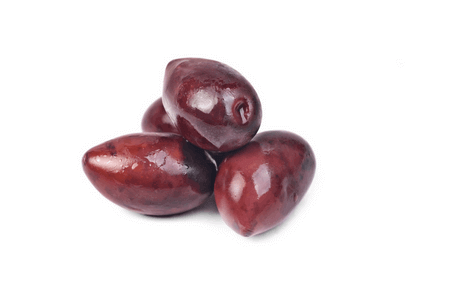
Curing Olives and Making Olive Oil
Curing Olives
raw olives are inedible. they are extremely bitter when raw. the olives we eat — ‘table olives’ — have been cured.
there are four methods for curing olives:
- Water-curing
- very labor intensive; eg, change water each day, for at least 25 days. ad-free simple instructions are here.
- Brine-curing
- weekly effort for up to 6 weeks. ad-free simple instructions are here.
- Dry salt-curing
- a traditional method and, fully ripe olives are required (black colored olives). very simple (traditional) method takes up to 3 weeks. instructions are here.
- Lye-curing
- a cool YouTube vid with music is here. their website instructions is here. thanks to Oh, The Things We’ll Make!
also, instructions for all four methods is here too: https://www.wikihow.com/Cure-Olives
Making Olive Oil
it’s a long, labor intensive process ;). making olive oil would be a labor of love.
a recipe for How to Make Olive Oil From Scratch. very ad-intensive.
i found this fascinating vid featuring two HUGE farms in Spain. learn about the history, see how olives are picked, the types of olive oils and … rather quickly shows how olive oil is made.
Cooking with Olive Oil
search “olive oil” at NIH’s PubMed site (peer reviewed studies). you’ll read over and over how olive oil is a “health-promoting component of the Mediterranean diet”, “A Mediterranean diet showed protective action against colorectal cancer”, “Mediterranean diet … [lowers] risk of cardiovascular disease”, etc. every article highlights the positive effects of olive oil.
so cook with it! 😉 here’s a conversion chart. you can replace butter & margarine with olive oil.
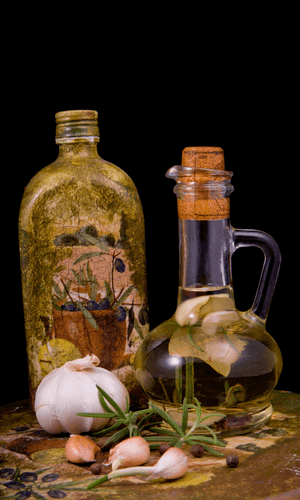
Health benefits of Olive Oil and Olive leaves
1, 2 HEPPY cannot take any responsibility for any adverse effects from the use of plants. Always seek advice from a professional before using a plant for food or medicinally. This information is intended for educational purposes only and should not be considered as a recommendation or an endorsement of any particular medical or health treatment.
extra virgin olive oil and olive leaves are LOADED with healthy bioactive compounds.
Olea europaea L. fruits and leaves are a matrix rich in bioactive compounds such as unsaturated acids, phenolics, phytosterols…The main components are fatty acids, in particular oleic and linoleic acids. NIH / PubMed, “Health Effects of Phenolic Compounds Found in Extra-Virgin Olive Oil, By-Products, and Leaf of Olea europaea L.“
Extra virgin olive oil
Extra virgin olive oil is responsible for a large part of many health benefits associated to Mediterranean diet as it is a fundamental ingredient of this diet.
the daily consumption of Extra virgin olive oil (EVOO) provides health benefits such as cardioprotective, antioxidant, anti-inflammatory, anti-tumor properties. EVOO also acts as regulator of the intestinal microbiota, among others.
why is the EVOO so healthy? EVOO has important phenolic compounds.
1. Hydroxytyrosol (HXT). HXT is considered the most powerful antioxidant compound. HXT has a molecular structure that’s beneficial. “its regular consumption has several beneficial effects such as antioxidant, anti-inflammatory, anticancer, and as a protector of skin and eyes, etc.”
2. Oleuropein. it’s best known for its blood pressure-lowering effect. Oleuropein has been shown to have cardioprotective, anti-inflammatory, antioxidant, anti-cancer, anti-angiogenic and neuroprotective functions, and thus may be of therapeutic potential for a variety of human disorders.
3. Oleocanthal. Oleocanthal has recently emerged as a potential therapeutic agent against a variety of diseases, including cancer, inflammation, and neurodegenerative and cardiovascular diseases.
4. Lignans. Lignan is of increasing interest because of their potential beneficial properties such as anticancerogenic, antioxidant, estrogenic, and antiestrogenic activities.
minor healthy-promoting phenolic compounds include Secoiridoids, Phenolics, Phenolic acids, and Flavonoids.
the quality of EVOO is affected light, temperature, oxygen presence and packaging material. buy quality EVOO to assure that YOU’RE getting all the health benefits possible.
Olive leaves
olive leaves and olive-leaf tea is a traditional food the Mediterranean region. it’s use is widespread. olive leaf extracts have been sold as dried leaves, powders, extracts, or tablets used as herbal teas or food supplements, available all over the world.
many studies have demonstrated important biological properties. examples include positive effects on cancer cells, anti-atherosclerotic, anti-fungal, hypoglycemic, and cardioprotective effects. radio-protective and anti-proliferative are other benefits.
Olive leaf extract (OLE) fights against diabetes. a recent study reported that 20 healthy subjects after an intake of 20 mg of OLE before lunch showed an improved post prandial glycemic profile by reducing glucose and increasing insulin. in overweight middle-aged men at risk of developing diabetes, supplementation with olive leaf polyphenols for 12 weeks significantly improved insulin sensitivity and pancreatic ß-cell secretory capacity.
NIH / PubMed, “Health Effects of Phenolic Compounds Found in Extra-Virgin Olive Oil, By-Products, and Leaf of Olea europaea L.“
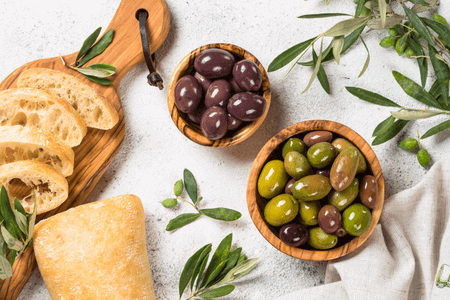
Propagating Olive Trees: cuttings, division, grafting, layering and seeding
air layering and by cuttings are the optimal methods of propagation. propagation by seed is possible, but the plants takes twice the years to mature (twice as long before she fruits).
Propagation by Layering
air layer Olive Trees as you would air layer any plant. the process is very easy and successful!
- an ad-free & short guide from the University of Florida.
- a 6 min YouTube tutorial for beginners from the University of Connecticut.
*** DON’T be concerned about finding a vid for air layering Olive Trees. air layering is air layering 😉
Propagation by Cuttings
propagate Olive Trees but cuttings … as you would air layer any plant. the process is very easy and successful!
- take cuttings from 1-year branch, in the summer after new growth has hardened.
- select a 8″ (20cm) long cutting from a healthy branch tip.
- the cutting will be thinner than a pencil (ie, use a healthy branch tip).
- strip off all leaves except a few at the tip.
- use rooting hormone to improve success and for healthy root development.
- use a rooting-friendly soil. mixtures vary but are usually made of peat moss, clean sand, perlite, vermiculite, and/or cocopeat (made from coconut husk).
- keep cutting moist. spray water on the cutting twice daily. covering a container with plastic also helps retain moisture.
Olive Trees growing at HEPPY™
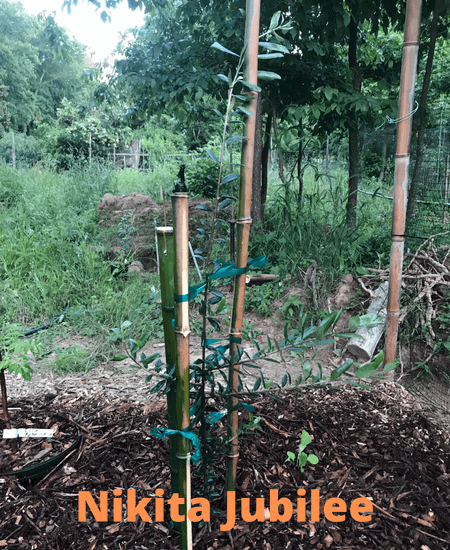

Nikita Jubilee (Olea europaea)
we purchased ‘Nikki’ from One Green World in early 2022. she was $30.00 for a 1 gallon pot.
we planted Nikki in June 2022. she was growing well in the 1 gallon pot and once planted, she’s started growing faster. the Nikita Jubilee Olive Tree grows vigorously and is a solid zone 7 tree.
the Nikita Jubilee Olive Tree is early ripening and very cold hardy. it’s prized for its productivity and flavorful, large fruit. use the olives to make green or black olives. it also make flavorful olive oil.
Santa Caterina (Olea europaea)
we purchased ‘Caterina’ from One Green World in early 2022. she was $35.00 for a 1 gallon pot.
we planted Caterina in June 2022. she was NOT growing well in the 1 gallon pot at the time we planted her. once planted in soil she’s began to growing OK. the Santa Caterina Olive tree is listed as a zone 7b tree.
the Santa Caterina Olive Tree is early ripening and very cold hardy. it’s prized for its productivity and flavorful, large fruit. use the olives to make green or black olives. it also make flavorful olive oil.



